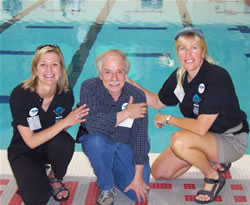 Martin Klein still thinks of himself as a student, despite the fact that he’s had a very successful career with a string of impressive accomplishments. It’s a modest attitude from someone in his position, but it holds an important message for today’s students as they consider their careers and the educational paths they’ll follow.
Martin Klein still thinks of himself as a student, despite the fact that he’s had a very successful career with a string of impressive accomplishments. It’s a modest attitude from someone in his position, but it holds an important message for today’s students as they consider their careers and the educational paths they’ll follow.
Within just six years of finishing college, Klein had founded Klein Associates, a company whose name quickly became synonymous with side scan sonar. He credits meeting Harold Edgerton with sending him in the direction that was to become his career. “When I was a senior at MIT, I visited Edgerton’s lab and asked if he had anything interesting to work on,” he recalls. “My life was never the same again.”
Edgerton, who is famous for developing strobe lights and flash photography, among other things, had worked with Jacques Cousteau trying to figure out how to use a camera seven miles below the ocean’s surface; in order to position the camera, they had developed a ‘pinger’ sonar device. Edgerton was trying to convert the pinger to a ‘mud penetrator’ to trace the sediments below Boston Harbor. Klein’s knowledge of transistors enabled him to help clean up the circuits on the device, clearing up problems they’d been having with unsatisfactory trace noises.
"Just because someone gives you a degree, that doesn’t mean you’re done learning."
Jumping in at the Deep End
Klein graduated in the fall of 1962 and soon found himself in the middle of a historic event – the search for the U.S. submarine Thresher, which had sunk in 8,400 feet of water off the coast of New England in April 1963. “There are certain events that shake the world, and in the oceanography community this was a huge moment,” he explains.
“Everyone wanted to find the Thresher, but deep-water searching was in its infancy,” he continues. In 1960 Jacques Picard and (current MATE National Advisory Committee member) Don Walsh had traveled in the bathyscaphe Trieste to the deepest part of the ocean, so the Trieste was brought in for the search. Klein found himself in charge of the team that was assigned to build a side scan sonar for the Trieste.
The Thresher was eventually found (but with a magnetometer and a towed sled), and participating in the search inspired Klein to improve existing side scan sonar technology with higher frequency and a narrower sonar beam – in order to get higher resolution pictures. Working at Edgerton, Germeshausen, and Grier (which later became EG&G), he began to develop a high resolution, towed, side scan sonar. That led to the first commercially successful side scan sonar (in 1966) and on into a career that has included everything from developing side scan sonar equipment and training customers to use it through participating in exciting expeditions (such as helping to find a 2,000-year-old ship off the coast of Turkey).
Life-Long Learning
“I often tell people that if you’re going to work in the ocean, you’re going to have to know everything,” Klein says, smiling. “That means a lot of technical things, such as hydrodynamics, physics, and oceanography, but also practical skills like tying up the boat, working with people who speak another language, and having to make do in a remote place without an electronics store around the corner.”
“It’s kind of a cliché, but I encourage students to take every possible opportunity to learn all they can – and then keep learning,” he continues. “Just because someone gives you a degree, that doesn’t mean you’re done learning.”
“Students will find themselves wondering why they need to learn something, but once they are working in the ocean, they’ll find out really fast that they really did need to know it,” he adds. “Marine archaeology is a great example: it’s very multi-disciplinary – involving computers, hydrodynamics, history, languages, oceanography, and commerce, to name just a few fields.”
"Klein graduated in the fall of 1962 and soon found himself in the middle of a historic event – the search for the U.S. submarine Thresher"
Sharing Knowledge at the Student ROV Competition
Klein participated in the recent national student ROV design competition as a guest speaker, poster judge, and informal advisor. “My experience was thrilling,” he enthuses. “Just to be in that environment with all the students – to witness their tremendous knowledge, poise, and skill – was wonderful.”
With his diverse career, Klein has a lot of experience to offer. “I’m not a theoretician – I go out and come back with results – so I can share my experience in making things happen,” he says.
“But on the other hand, I’m still a student, still learning – and I can learn a great deal from the students themselves,” he adds. “They don’t necessarily know something can’t be done, so they get very creative; and it’s inspiring to see them work as teams, learning about success and failure together.”
With experiences like the ROV competition and mentors like Martin Klein, who knows how many of these students will go on to be the pioneers in the next generation of marine technology?
<< Back to Profiles Start Page
|
|
